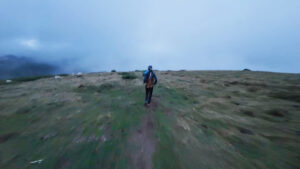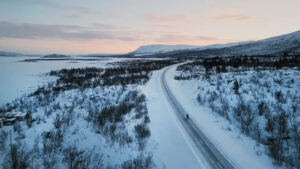Winter K2 has wrapped up, with no shortage of drama. The season saw the first-ever winter summit but also tragedy, accusations, and confusion.
Whether in 1939 or 2021, K2 remains one of the hardest mountains in the world to climb. The documentary, The Ghosts of K2, tells the story of two early expeditions to the Savage Mountain: a 1939 attempt led by Fritz Wiessner and a 1953 expedition led by Charles Houston. Both siege-style assaults ended in tragedy.
If it weren’t for the life-and-death stakes, Wiessner’s expedition might be described as farcical. The year before Wiessner’s team set out for K2, a team of American mountaineers had laid the groundwork for a successful summit. The purpose of their expedition was to find a route up K2. Not only did they find a feasible route, they almost summited, stopping just 800m short of the top.

Wiessner’s 1939 expedition, from left: George Sheldon, Chappell Cranmer, Jack Durrance, George Trench. Seated: Eaton Cromwell, Fritz Wiessner, Dudley Wolfe. Photo: Jack Durrance Collection
Wiessner was confident: He was the best climber in America and a natural mountaineer. Unfortunately, he was not a natural leader. His K2 team featured only one solid climber, Jack Durrance. The rest were “young and inexperienced or old and inexperienced.”
After the grueling hike to the foot of K2, fractures were already appearing within his team. The deputy leader, Tony Cromwell, realized that he was in over his head and almost immediately pressed to go home. But Wiessner soldiered on. Slowly, they inched up the mountain. But with each new camp, his team dwindled. One by one, his inexperienced climbers retreated, suffering from altitude sickness and frostbite. After six weeks and eight camps, only Wiessner, an eccentric playboy named Dudley Wolfe, and Passang Sherpa remained high on the mountain.
Wolfe was unable to make the final push, but Wiessner and Passang Sherpa made it within a few hundred feet of the summit. Fourteen years before Everest was summited, bagging K2 in 1939 would have been a mind-boggling achievement. Only superstition stopped them. As night closed in, Passang Sherpa urged Wiessner to turn back for fear of upsetting the night spirits of the mountain. On their descent, they somehow lost both pairs of crampons and a second summit push became an impossibility.

Both the 1939 and the 1953 expeditions used the same route and siege-style camp system. Photo: The American Alpine Association
Back at Base Camp, Cromwell and the team had decided that their colleagues were dead, based on the curious reasoning that they had “shouted up the mountain” and heard an avalanche. In an act of betrayal fit for Hollywood, they stripped the lower camps and packed up. As Wiessner, Passang, and Wolfe descended, they found no sleeping bags and food scattered across the snow. They were forced lower and lower, exhausted and starving. In an unbelievable twist, Wolfe decided to stay on the mountain, believing Wiessner would quickly return from Base Camp for another attempt. Instead, he was left for a week, “the highest and loneliest man in the world.”
Wiessner arrived at the base of K2 and found his team ready to leave. He was furious but completely spent. Durrance was sent up to retrieve Wolfe, only to return after three days without him. Next, four Sherpas tried their luck. They found Wolfe alive but tentbound, crippled by apathy after too long at altitude. Unable to convince him to leave his tent, they spent a night at a lower camp. The next morning, three of them went back up to bring him down. None returned.
Soon after, the weather broke over K2. No more rescue attempts would be possible. Sick and deeply divided, the expedition headed home in three separate parties.
The 1953 expedition was much more professional. Charles Houston and Bob Bates put together a team of climbers designed to mesh. They avoided primadonnas and prickly personalities, building a team that could spend extended periods cooped up in a tent together.

The only Brit on the 1953 expedition, Capt. Streather, at Camp 3. Photo: The American Alpine Association
This would prove important. Having slogged up to Camp 8 and in high spirits, the weather turned, and a freak storm hit the mountain. While they waited it out, a case of suspected cramp for climber Art Gilkey turned out to be a blood clot. His condition deteriorated rapidly, and it became clear that they would have to make a break for it if he was to survive.
Their attempt to lower him down the mountain went severely wrong almost immediately. Roped together, the group took a tumble. Only one climber, an ice ax, and a perfectly positioned rock saved their lives. Christened The Belay, it was arguably the greatest save in mountaineering history.
It was a temporary reprieve for Gilkey. They were forced to leave him tethered to the mountain while they found the next camp, and an avalanche must have taken him before they returned. Later, they encountered his remains on blood-splattered rocks on the lower slopes.
It is a dark film and tackles some of the questions raised by this year’s K2 season. Who judges whether a climber is competent enough? What is an acceptable level of risk? The 1953 team took a ballot to determine who should be part of the summit team, and the two climbers with children were automatically eliminated. “You can’t go to these mountains and think about your family.”
You can watch the full documentary below.






